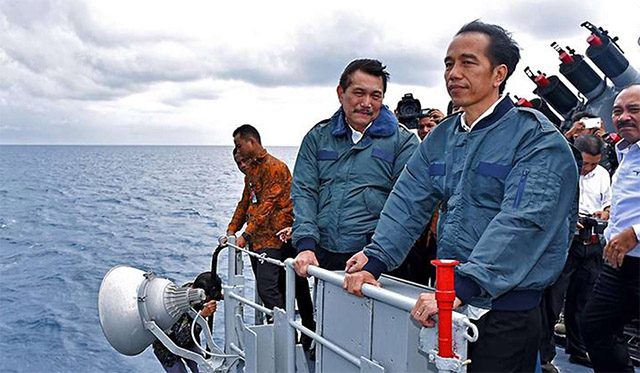
Following the supposed failure of President Rodrigo Duterte to make a gesture this week to assert the country’s maritime claims, a viral Facebook post raised a similar move by Indonesian President Joko Widodo two years ago.
Widodo boarded a warship in June 2016 to send a message to China.
In a Facebook post, blogger Max Defense Philippines recalled that Widodo sailed to the South China Sea to visit Natuna Islands, a group of small islands within Indonesia’s exclusive economic zone.
The blog did not drop names of any government official, but cited the controversial jet ski trip in Aurora to send off Filipino scientists to the uncontested underwater Philippine Rise that same day:
“And he (Widodo) didn’t boast riding a jet ski and plant flags which was ridiculously undoable, but without fanfare he did plant flags in Natuna Islands, and made it known to the whole world that Natuna Islands and its 200 nautical mile EEZ are Indonesia’s domain, and is for the Indonesian people.”
Although the islands themselves are not disputed by China, the waters near the Natuna chain have overlapping interests and rights with China—similar to the West Philippine Sea.
The move was described by Indonesian officials as the strongest message they’ve sent to China.
“In the course of our history, we’ve never been this stern (with China). This is also to demonstrate that the president is not taking the issue lightly,” Indonesian Security Minister Luhut Pandjaitan told The Jakarta Post.
Bold gestures?
Widodo held a cabinet meeting aboard a warship off the island chain.
Max Defense observed that Indonesia’s gesture was against the Asian communist power despite having no “guaranteed” foreign aid from the United States. The Philippines, in contrast, has a defense treaty with a “nuclear superpower” expected to come to the country’s aid if attacked by a foreign state.
While Indonesia’s maritime claims do not largely overlap with China unlike the Philippines, it has several times made clear its stance as neighbors are embroiled in a years-long row.
Indonesia’s assertiveness in protecting its maritime sovereignty was similarly seen in 2016 when its patrol boats blew up foreign vessels and arrested fishermen not only from China, but also from Malaysia and Indonesia as well, to send a message against illegal fishing.
In July 2017, Indonesia renamed the northern part of its EEZ identified as part of the South China China to North Natuna Sea. China dismissed the effort as “meaningless.”

“This (system) would allow the international community to know whose territory they pass through,” Indonesia’s Deputy Minister for Marine Sovereignty said in a report.
From furniture-maker to president
Like Duterte, Widodo came from a local government post before becoming president.
A BBC feature described Widodo, a former furniture-maker, as a popular candidate among the youth for his “promise of change and reputation as a clean politician” and “in sharp contrast to the country’s previous prime ministers.”
When inaugurated in 2014, Widodo promised to strengthen Indonesia’s naval power.
Duterte and Widodo met once as part of the chief executive’s first international visits around Asia after being sworn as president in June 2016. The two also agree on some policy points such as on a stringent anti-drug campaign and opposing what they perceive as the European Union’s meddling in internal issues.
A more thorough comparison of Duterte and Widodo:
How effective was Duterte and Jokowi’s transition from local to national politics?









